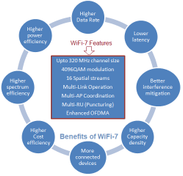VLC vs. WiFi: Key Differences Explained
This article compares VLC (Visible Light Communication) and WiFi, outlining the key differences between these wireless technologies. We’ll cover the basics of each, including their features, to help you understand their respective strengths and weaknesses.
VLC Communication

Here are the key features of VLC communication:
- VLC utilizes the visible light portion of the electromagnetic spectrum.
- It operates within a wavelength range of 380 nm to 750 nm (corresponding to a frequency range of 430 THz to 790 THz).
- Data is modulated onto the light source before transmission.
- Unlike RF communication, VLC doesn’t require a Power Amplifier (PA).
- LEDs and lasers are used as transmitters (light sources), while photodiodes act as receivers.
- LiFi is one notable application of VLC.
WiFi Communication

The following are the key features of WiFi technology:
-
WiFi operates on radio frequencies, typically around 2.5 GHz or 5 GHz.
-
WiFi adheres to various WLAN standards (e.g., 802.11a, 802.11n, 802.11ac, 802.11ad, 802.11ax) defined by the IEEE to achieve different data rates and coverage ranges.
-
A WiFi Access Point (AP) or Router connects to the internet via a broadband cable or cellular network.
-
WiFi-enabled devices like mobile phones, tablets, and laptops connect to the AP (or router) to access the internet.
-
WiFi networks can operate in two modes: ad-hoc (Basic Service Set - BSS) and infrastructure (Extended Service Set - ESS).
-
In BSS mode, WLAN-compliant stations (STAs) communicate directly. In ESS mode, STAs communicate with APs to access the internet.
-
WiFi supports varying speeds and coverage ranges depending on the implemented standard in the devices (STAs, APs).
- 802.11a supports up to 54 Mbps.
- 802.11b supports up to 11 Mbps.
- 802.11n supports 72 Mbps/150 Mbps, depending on the bandwidth (20MHz/40MHz).
- 802.11ac wave-1 supports up to 1.3 Gbps (80MHz, 3 streams, 256QAM).
- 802.11ac wave-2 supports up to 3.5 Gbps (160MHz, 4 streams, 256QAM).
-
WiFi can achieve distance coverage from 70 meters (indoor) to 250 meters (outdoor).
Key Specification Differences
| Specifications | VLC | WiFi |
|---|---|---|
| Full form | Visible Light Communication | Wireless Fidelity |
| Maturity of system | Less | More |
| Speed | 1Gbps | 1Gbps |
| Coverage Range | short (few meters) | Higher (tens of meters) |
| External Power | Do not require external power as it has power for LED lamp. | Need external power |
| Backhaul | Ethernet or powerline communication is used. | It is provided using ethernet or broadband connection. |
| RF and Antenna Front end | Do not required, moreover illumination power is used as transmit power. | Required, as wifi operates using EM waves. |
| Security | More secure as it confines the data transmission to one area. | Less secure as EM waves can not be confined to one particular region, Separate encryption techniques are to be employed in order to make wifi connection more robust. |
| Data density/Frequency re-use | Interference is bounded and hence reuse efficiency is higher. | WiFI prone to co-channel interference and hence more wifi nodes do not lead to increase in the data capacity linearly as it can be. |
| NLOS performance | communication can not be established in non line of sight if reflected signal is poor. | communication is possible but performance gets degraded if attenuation is more due to signal fading. |
| BOM (i.e. Bill of Materials) | Do not require expensive components such as RF devices and antenna. It is cheaper system. | RF and antenna are must for wifi to be exist. Hence it is costly compare to VLC. |
Conclusion
Hopefully, this has helped you understand the basics of VLC vs. WiFi and the key differences between them. For further reading, you might find these resources useful:
 RF
RF



